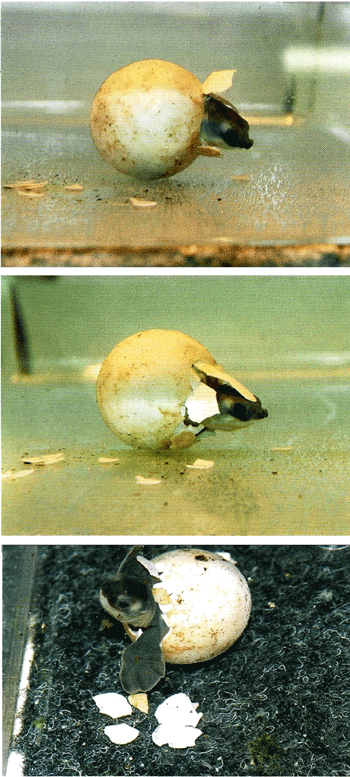Reproduction of the pig-nosed turtle Carettochelys insculpta
(RAMSAY, 1886) at the
Rotterdam Zoo. Radiata 14(3):3-12.
Gerard Visser & Henk Zwartepoorte
Captive breeding
In several zoos mating attempts and oviposition has been observed, although much of the time, eggs have
been deposited in the water. On May 25th 2001, eggs were found of the bottom of a tank in the Wilhelma Zoo
(Stuttgart, Germany). Most eggs were eaten or destroyed by the fish in the tank (Pangasius spp.)
or by the turtles themselves - only two could be saved for incubation. This was done at 30 °C and 80%
humidity in Perlite. The humidity was increased after 136 days, and one juvenile hatched on 4 October 2001,
after assisted hatching. The other embryo had died, and it was assumed that assited hatching could be
necessary. The breeding group consisted of seven animals, many of which had been living in the Zoo for 27
years (KOCH pers. comm., ROEMPP 2003).
Also in 2001, a hatchling was found swimming in the main pool of an exhibit at the Bronx Zoo (New York,
U.S.A.), among fishes, turtles and crocodiles. It must have emerged from a clutch that had been
deposited on the nesting beach in the exhibit. After intensive search of the enclosure, more eggs were
found but these did not develop during incubation (ROEMPP 2003).
In September 2003, ten hatchlings were found in a large, off-exhibit enclosure in the Miami Metrozoo
(Florida, U.S.A.). It is believed that these hatchlings were from two separate, undetected nests. The
parents had been maintained in that pool for several years (Anonymous 2004).
Breeding at Rotterdam Zoo
As stated above, the breeding trio shared the large aqua-terrarium during parts of 2004. There was a lot
of aggression between them and nothing indicated that copulations had taken place. Nevertheless, this must
have been the case, as fertile eggs were produced in 2005. Mating behaviour was probably interpreted as
aggressive behaviour. Courtship and mating in this species sometimes looks very aggressive.
This means that the female, which arrived as an adult animal in 1978, had produced her first clutch of
fertile eggs almost 27 years after her arrival at the zoo.
After we noticed increasing damage on the carapace of the female, the male was taken out of the public
tank in November 2004.
|
The female laid 24 eggs on January 10, 2005. In search of a suitable nesting site the female had ignored the beach that had been specifically made for her by the keeping staff, and had left the exhibit through the planter that separates the aquatic part of the tank from the public area. She was found by the night watchman very early in the morning at the bottom of the stairs leading to the public lavatory. Of the three eggs that she laid there, two were broken. After the female was recovered from the public area she was put in an off-exhibit container with a layer of peat, where she produced the rest of the eggs, twenty one in number, approximately one hour after the injection of Calcium-Sandoz and Oxytocine. Incubation |

